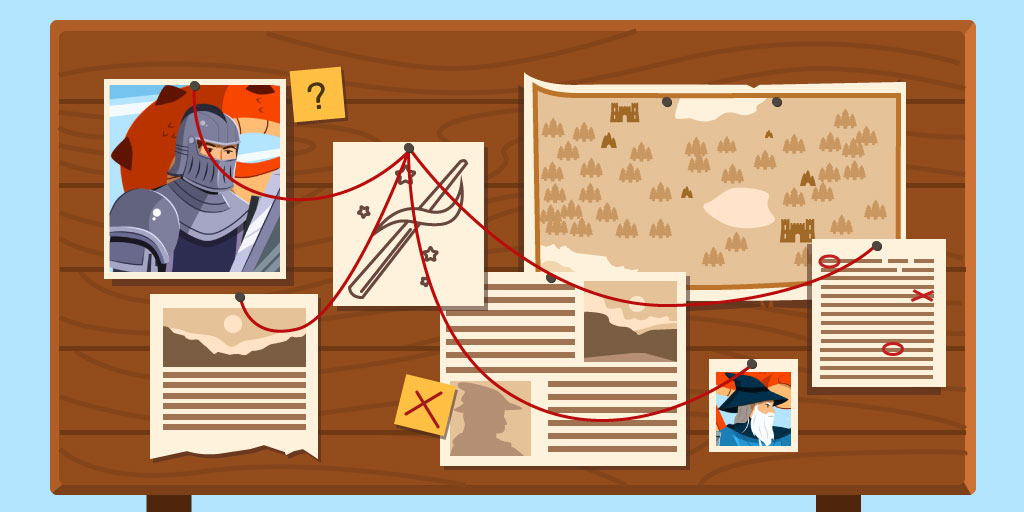Writing a short story is a great way to gain experience as a writer. Writing short stories helps you hone your writing skills, experiment with different styles, and develop your voice as a writer. Once you have mastered the art of writing short stories, you may find it easier to tackle the larger project of writing a novel.
A short story has a narrower scope than a novel. It is designed to be a concise, self-contained piece of fiction that can be read in one sitting. This means that you don’t have to create a complex world with a large cast of characters, intricate plotlines, and multiple subplots. Instead, you can focus on a single idea or event and develop it fully in a few pages.
Writing a good short story still requires skill, creativity, and dedication. To start you off on this journey, we have broken down the process into 10 steps, with plenty of ideas to help you find your footing.
- Generate Your Short Story Idea
- Create Compelling Characters
- Outline Your Short Story
- Craft a Strong Opening
- Build Your Story
- Write an Unforgettable Ending
- Edit, Refine, and Polish
- Title Your Short Story
- Get Valuable Feedback
- Publish Your Short Story
1. Generate Your Short Story Idea

Generating ideas for short story writing can be challenging, but we have some strategies that can help. The most important thing is to be curious about the world around you. Don’t be afraid to explore different ideas and experiment with different approaches until you find one that resonates with you.
Brainstorming is a very useful habit to adopt, either on your own or with a group. Install a note-taking app on your phone or carry a notebook so that you can write down ideas that you collect during the day. Then you can do some brainstorming later when you have time.
Observation
Pay attention to the world around you. Watch and listen to people and observe places and events. Consider how they could be transformed into a story.
Perhaps there’s an abandoned or creepy-looking house in your neighborhood. If you walk past a historical landmark every day, find out more about it and see if anything sparks your imagination. Look out for interesting behaviors like big confrontations, reckless acts, or courageous actions in your surroundings.
Observation doesn’t have to be passive. You can, for example, ask a waitress, janitor, or concierge about the most interesting people or groups they have served. People love to talk, especially to tell interesting stories.
Personal Experience
Think about your own life experiences or those of people you know. Consider how they can be fictionalized and turned into a story, but be careful to change them enough not to offend people.
Do you have a friend who is disabled or struggling with a psychological disorder? Have you lost a close relative to an illness or accident? Has someone you know won some money? Have you been the victim of a crime? Do you know someone who has been cheated on or otherwise betrayed? Have you been put in touch with a long-lost family member?
Maybe someone in your life has visited an interesting place or has an unusual job. Our lives are packed with potential stories to be collected and re-imagined.
Read the News
Following the news and watching documentaries can introduce you to stories that could be adapted into fiction.
- People are interested in stories that focus on people’s lives, struggles, and achievements can provide rich material for character-driven stories.
- Crime or disaster stories can provide the basis for suspenseful, action-packed stories. YouTube is replete with popular channels that tell such stories.
- News stories about social issues such as discrimination, immigration, or poverty can inspire stories that explore the effects of these themes on people.
- Advances in artificial intelligence, genetics, space exploration, or other science and technology fields can provide the basis for stories about the future.
Writing Prompts
If you’re feeling stuck, a writing prompt can help you get started. You can find prompts online or in writing books. They can be anything from a single word to a full sentence or scenario.
Here are some example prompts (feel free to see where they lead you!):
- A character is stranded somewhere and must survive using only their wits and the resources available to them.
- A character discovers a hidden room in their home that has been locked for years.
- A character can see the future, but is powerless to change it.
- A character is the only one who can experience something that no one else can.
- A character is haunted by a recurring nightmare that seems to be coming true.
- An inanimate object like a tree or a piece of furniture has some interesting stories to tell.
Ask “What If?” Questions
Ask yourself “what if?” questions about a situation or a character.
- What if a group of strangers were trapped somewhere together and one of them was a murderer?
- What if a person found out that they were actually a robot, programmed to believe they were human?
- What if a character with a lot of unfinished business on earth continued “living” as a ghost?
Craft of Writing Quiz (Easy)

2. Create Compelling Characters

A successful short story must contain at least one main character that engages the readers.
In a short story, you don’t have the space to go overboard with complete descriptions of their backstories, current circumstances, personalities, likes, dislikes, strengths, weaknesses, fears, and aspirations.
But it is a good idea to delve into these details about your main character for yourself so that you can ensure that they act and respond consistently throughout.
To make your characters sympathetic and relatable to your readers, try some of the following:
- Give your characters some flaws. Imperfections make characters more relatable and interesting. Readers can see themselves in your characters’ poor self-esteem, fearfulness, or bad temper.
- Use vivid details to describe your characters, including their physical appearance, reactions, and mannerisms. This will help your readers visualize them and bring them to life.
- Characters who struggle with inner conflicts, such as moral dilemmas or conflicting desires, can be easily relatable because most readers have experienced something similar.
- Give them realistic motivations for their actions, such as a wish to protect their loved ones or a need to be liked.
- Give your characters complex emotions, like the sadness and fear with which your readers often wrestle.
- Readers relate well to characters if they can root for their success. That’s why characters who want to succeed, find love, escape, or survive are very compelling.
3. Outline Your Short Story

Some writers are lucky enough to start writing and see events unfold automatically in front of them, but most of us need to know more or less where we are going right from the start. An outline will help you organize your thoughts and ensure that your story covers the events conveys the message you want. Importantly, your outline is a rough guide, and not a rigid set of rules. You may need to make changes as you write, but an outline can tell you roughly where your story is going and how you want to get there.
Start by creating a short 200- to 300-word plot summary. If you’ve thought through your story idea, you should be able to outline the main events without which that story cannot be told. Next, expand this outline by adding detail. This will most likely take the form of listing out events or scenes that connect the essential events with each other. It might help to divide your story into three parts: the opening, the middle and the end.
The opening should introduce the setting, characters, and conflict. But make sure that instead of long descriptions, they’re introduced through actions and events that move the story forward. The middle should build tension and develop the conflict. The end should resolve the conflict and bring the story to a satisfying or thought-provoking conclusion. Plot out the ways your main characters will evolve throughout the story, and ensure that the events you have outlined capture this.
4. Craft a Strong Opening
The opening scene of your story should grab your reader’s attention and make them want to read further. No one will put down a story that starts with a sentence like, “The smell of smoke filled the air, and I knew that something was burning”, or “The old house on the hill had always been rumored to be haunted”, or “The sound of the gunshot echoed through the empty streets.”
These are not just irresistible sentences; they also introduce captivating scenes that will grip your readers: a fire, a spooky house, or a crime. In addition, they set a probable tone for the rest of the story: panic, dark, and suspenseful.
Best of all, they include subtle hints of what’s to come, creating a sense of anticipation and suspense. Starting with a description of how good life currently is will simply be boring. A description of the main character or the environment also won’t grab readers at all.
5. Build Your Story

Once you’ve set the scene for the story, you can start to build it out. There are no rules here. The process will depend on the type of story you are writing. But there are a few things to keep in mind regardless of the details of your story.
Develop the Conflict
The conflict is the heart of your story. This is the element that drives the plot forward. It should create tension and keep your reader engaged throughout. Without becoming too specific, here are some types of conflict into which you can drill deeper:
- Your characters have a conflict with another character or group, such as a criminal, a love interest, a competitor, or parent, or any other.
- Your characters struggle against natural forces, such as an earthquake, a flood, a fire, or an animal.
- Your characters battle against those in power or authority, such as a government, corporation, or other institution.
- Your characters have a personal struggle, like a difficult decision, an addiction, or a personality flaw.
- Your characters cope with the effects of past trauma, memories, or experiences.
- Your characters struggle against paranormal forces, like ghosts or demons.
- Your characters fight against the negative effects of science or technology, such as surveillance, genetic modifications, an out-of-control appliance, and so forth.
Create Tension
Use tension to create a sense of danger, urgency, and excitement. Your conflict already develops some tension, but you can ramp it up even further by using some of the following strategies.
- Use foreshadowing: Like you did in your opening, drop subtle hints throughout the story of distressing events that are inevitable if your character doesn’t get things right.
- Raise the stakes: As the story progresses, make the consequences of the main character’s failure more dire.
- Be surprising: Use a plot twist to stun the reader and keep them engaged.
- Maintain the pace: Keep your sentences relatively short and your descriptions of the environment brief, in order to maintain the suspense.
- Use a ticking clock: Introduce a sense of urgency by adding a deadline or time limit.
- Create mystery: Use a false clue or red herring to mislead the reader and add a layer of tension and uncertainty.
- Create anticipation: Reveal information to the reader that the characters are unaware of.
- Choose good words: Terror, panic, and dread are better words than fear. Now, immediately, and emergency are good urgency words. Foreboding and premonition are good words to build anticipation.
Use Descriptive Language
Use descriptive language to create a vivid picture in the reader’s mind. This will help draw them into the story and engage their senses. Here are some ideas.
- Show, don’t tell. Show an event as it happens, instead of writing a couple of sentences to tell readers that it has happened. This puts the reader in the middle of the action.
- Use sensory language that appeals to the five senses. For example, “The pale moon casts a soft glow over the forest.” “The sharp crack of a breaking branch.”
- Use specific, concrete language. For example, rather than saying tree, say tall oak tree with gnarled branches and a thick trunk.
- Use active language that creates a sense of movement or action. For example, he pulled the trigger, she ran down the stairs, or they jumped into the river.
- Use strong verbs and adjectives. Rather than “The bird flew,” say “The bird soared.” Instead of “cold water,” say “frigid water”.
- Use metaphors and similes to create strong visual images. For example, “The rain was a curtain, shrouding the city in a veil of mist and darkness.” or, “The haunting wind howled like a pack of hungry wolves.”
Your Story Message
Many short stories are centered around a specific message, such as the reminder that there is always a glimmer of light in difficult circumstances, or the encouragement to keep going when things are tough.
If this sounds too scholarly for your liking, remember that it is not necessary to come up with a deep and profound message. If you simply enjoy writing scary stories, that’s perfectly acceptable. But even scary stories can convey a message, even if it’s not especially profound, and it is your challenge to extract such a message from your tale.
In some cases, you’ll know the message before you start writing, because that may have been the motivating factor behind writing it. But in other cases, you will have to extract the message once you are done, or close to done, and then work it into the rest of your story.
6. Write an Unforgettable Ending

Since the ending of a short story is meant to leave a lasting impression on the reader, it is important to get it right. There are a few things you should try to incorporate in the ending.
Resolve the Conflict
The ending of your story should resolve the main conflict. It’s fine if some questions remain in the readers’ heads, but the main conflict should be wrapped up in a way that is satisfying, memorable, meaningful, or thought-provoking.
Don’t leave your story on a cliffhanger, or end with things completely unresolved so that the characters’ situation hasn’t changed.
Ideally, your ending should be unpredictable but fair. Your readers should feel that they could have seen it coming because of all your little hints. You cannot, for example, introduce a new character right at the end that was responsible for all the trouble.
The story should conclude in a way that answers most of the “why”, “how”, “what”, and “who” questions that the readers will have about the conflict.
Revisit the Opening Scene
Returning to the opening scene of the story right at the end can be a satisfying way to bring the story full circle.
Let’s revisit our example opening scene, “The sound of the gunshot echoed through the empty streets.”
If the story ends with the murder of the villain, you can repeat the gunshot echoing through the streets, but now, instead of being empty, the streets are filled with the whispering footsteps of the bereaved relatives.
End on an Emotional Climax
When they reach the end of the last sentence, your readers should ideally feel some strong emotion. Relief, happiness, despair, or any other powerful feeling. Engaging their emotions as well as their intellects is the best way to ensure that your story remains in readers’ heads after they finish it.
Avoid Cliches
Try to avoid cliche endings that are predictable and unoriginal. Instead, aim for an ending that is unique, unpredictable, and interesting. This is where you can solicit the help of friends and relatives who are honest enough to tell you that the ending that you believe to be original is actually predictable.
Use a Twist
A twist ending that surprises your reader is often fun and interesting, but you must be careful not to use a twist just for the sake of it. It should be integral to the plot and make sense in the context of the rest of the story.
When a twist is revealed, the reader may experience a rush of emotion, as they re-evaluate everything they thought they knew about the story and its characters. That is the type of reader engagement that you want.
Match the Tone
The ending should be consistent with the tone of the rest of the story to ensure that your readers aren’t disappointed. For example, someone who reads a lighthearted comedy will be happier with a funny ending than with a somber one. Conversely, someone who reads a dramatic tragedy is prepared for a somber ending, so a joke right at the end would be irritating.
7. Edit, Refine, and Polish

This step is crucial if you want your short story to be publishable, which is probably why you are writing it. But it’s also important for strengthening the story. While editing and refining, you can make sure that it makes sense and flows smoothly. You can also make changes that enhance the emotional impact and the message.
Consider some of these steps to finalize your story:
- Create distance: Take a one-week break from the story after finishing it. This will give you some distance and allow you to review it with the necessary critical perspective.
- Remove clumsy language: Read it out loud so that you can identify awkward phrasing, unnatural-sounding dialogue, and so on.
- Check for pacing: Remove unnecessary details or descriptions that don’t move the story forward. In a short story, every scene must contribute something important to the plot.
- Close the gaps: Make sure that there are no holes or inconsistencies in your plot, settings, and characters.
- Fix grammar and spelling: Use services like Grammarly or ProWritingAid to fix up your grammar, punctuation, spelling, and writing style.
8. Title Your Short Story

Choosing a title for your short story is a vital part of the writing process. It’s the first thing that readers will see, and those few words will often determine whether they read it or not.
It’s important to forget about clever marketing strategies. If your title suggests that your story is something that it actually isn’t, readers will be disappointed. Choose a title that accurately reflects the content and gives readers a sense of what they can expect.
Go for a title that is no more than three to five words long. Famous examples to emulate are “The Body Snatcher” by Robert Louis Stevenson, “The Magic Shop” by H.G. Wells, and “The Happy Prince” by Oscar Wilde.
9. Get Valuable Feedback

This is a psychologically daunting step, as you have to open yourself up to criticism and correction. But it can improve your short story beyond your wildest dreams and ensure that it is ready to be shared with a wide audience.
Feedback can come from various sources:
- Friends and family members are a good start for general feedback.
- Writing groups, which you can find at your local library or community center, can help you get more targeted feedback. There are also online groups at places like Scribophile and Critique Circle.
- Writers’ associations usually allow writers to connect with each other, so search the internet for your state or city’s name followed by writers’ association. National organizations like Mystery Writers of America and Romance Writers of America also connect writers.
10. Publish Your Short Story

The traditional route of publishing through an agent and large publisher is expensive and not particularly viable for lone short stories. But there are other routes where your chance of being published is greater.
There are lots of magazines that still publish short stories. Pick your favorite magazine and check whether it does so. The Atlantic, The New Yorker, New England Review, The Georgia Review, and Boulevard Magazine are good places to start.
Then there are websites and online marketplaces that accept short stories. These include Daily Science Fiction, The Horror Tree, Duotrope, Submittable, DarkMarkets, and many others. We are lucky to live in the 21st century, because now we also have short story podcasts. These include Clarkesworld Magazine, Nightmare Magazine, and Pseudopod.
For each of these publications, read the submission guidelines carefully and observe them to the letter. If you can read or listen to their previous publications, you will discover what they like.You can also try the self-publishing route on a platform like Amazon KDP, but it is better to have a collection of four or five short stories that will give your readers some value.
What Makes a Good Short Story?
In short, a piece of writing is a good short story if it has certain characteristics that make it stand out. Yes, good grammar and spelling are important, but those are minimum requirements, not features that make it stand out. Let’s look at some of those characteristics.
Concise and Focused
A good short story is focused and to the point. Every scene, sentence, and detail serves a clear purpose. It’s not like a novel, in which you can include large parts of a character’s history that play no further role in the story. Instead of going into depth on someone’s whole life or a big journey, it focusses very narrowly on one experience or one aspect of a character’s life.
A Lively, Relevant Intro
People who read short stories tend to read lots of them, so you must capture their attention with the gist of the plot right off the bat. You saw some examples above. Don’t write history or descriptions of the environment in the first paragraph, or at all, in fact. They must know after the first paragraph that they want to continue reading.
Fast-Paced
Because a short story tells a small story and tells it quickly, the pace of the tale should never drop off. You aren’t writing for novel readers who are happy to doze off gently through a third of the story while lying in their beds. Short story readers are completely focused on what they are reading and want to be totally engaged.
Keep it Simple
Keep the number of characters to a minimum, since you don’t have the space to develop them all properly. Mention their backstories when a detail is relevant, but don’t flesh them out. In addition, use only one point of conflict in the story, since there is no room to create more.
Emotional Resonance
A good short story evokes an emotional response from the reader, whether it be joy, sadness, fear, or some other emotion, and it leaves a lasting impression. You can achieve this by introducing a sympathetic main character, by making the conflict a memorable one, or by including a moving story message.
Sensory Intensity
Use all five senses together with some metaphors and similes to make readers feel like they’re in the middle of the action. For example, “The sky was a canvas of pink and orange, the clouds like brushstrokes across the horizon.” Or, “The crackle of a roaring fire filled the room, its warmth enveloping me like a comforting embrace.”
Unique and Original
It must tell a story that has not been told in the same form before. This means that you cannot settle for the first story idea that comes into your head. Once you have a story idea, query it through “why”, “what”, “who”, “where”, and “what if” questions and refine it as you go along.
A Memorable Message
The best short stories make good use of theme and symbolism to convey a deeper meaning or message, adding depth and complexity to the story.
Common Short Story Mistakes
Even experienced authors sometimes make some common mistakes when writing short stories, which either prevent them from being published, or diminish their impact and resonance with readers. Here are some common mistakes to watch out for.
Too Large Focus Area
A short story that does not focus narrowly enough on a sufficiently small situation and conflict ends up confused and underdeveloped. To solve this, ask yourself exactly what you want your story to do, and omit all the extras that aren’t central to this aim.
Wrong Point of View
If the story is told by the wrong character, it is harder for the reader to relate or to be emotionally involved. Instead, imagine your story as told by different characters, and pick the one that can tell the deepest version of the central storyline.
Inconsistent Point of View
Changing the point of view halfway through a scene is a form of cheating, because it gives readers insight into the thoughts of multiple characters. One good fix is to write from the first-person point of view, so you won’t be tempted to switch. A short story is too short to allow for multiple points of view anyway.
Over-Reliance on Exposition
Don’t rely too heavily on descriptions and explanations to convey information or backstory. This makes a short story tedious and boring. Instead, find ways to show this information through action and dialogue.
Clichéd Characters and Situations
Short stories that use clichés lack a unique voice and feel stale to read. The damsel in distress who needs to be rescued by the hero and the beautiful and popular high school student who is secretly unhappy have served their time. Instead, build a character and situation by combining characteristics that aren’t usually found together.
Why Should You Write Short Stories?

There are many reasons to write short stories. Overall, it’s a super self-development tool.
Improve Your Writing Skills
Writing short stories can help to improve your writing skills, as they require you to be clear, concise, and to the point. Even better, because they are so short, they allow you to experiment with different genres, styles, and themes, potentially improving the creativity in your writing as well as in your thinking. They can also help you to establish a regular writing routine, with the self-discipline that is required, and thereby develop the skills you need to take on larger writing projects.
Gain Visibility
Short stories can help you gain visibility & catch the attention of readers without taking a year of your time to write. Moreover, because they are short, they appeal to people with short attention spans and translate very well to YouTube scripts, short screenplays, and podcasts. This makes them highly suitable for our current times.
Scale up Your Writing
Short stories often develop into full-length novels. Ernest Hemingway said that many of his novels started as short stories. If it seems like too big a stretch to move from a short story to a novel, you can always convert it into a novella first. The typical novella ranges from 20,000 to 50,000 words, falling between a short story and a novel in length.
Short stories can also help you build a portfolio to show agents and publishers that you are serious about your writing, which may increase their willingness to help you become a published writer.
The Power of Short Stories
Short stories are a powerful form of storytelling that can convey a lot in a short amount of time. By focusing on a single character or event, they allow the author to create a powerful and focused narrative that can have a significant emotional impact on the reader. That’s why this has long been a form of great literary merit, with many acclaimed authors producing some of their finest works in the short story form.
Craft of Writing Quiz (Hard)








